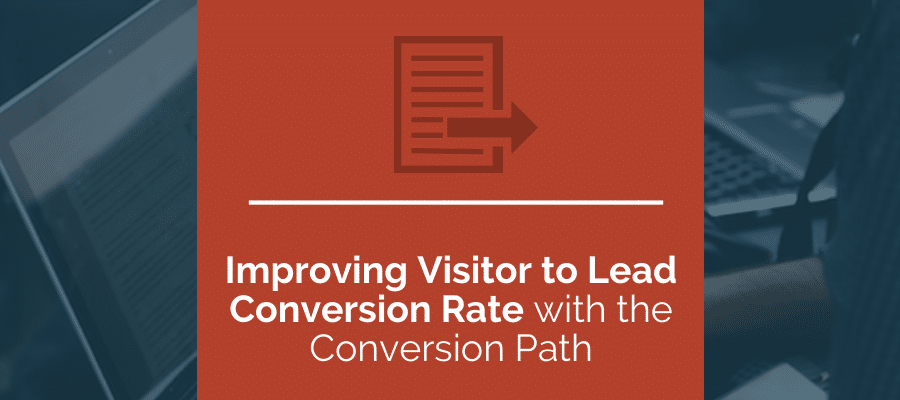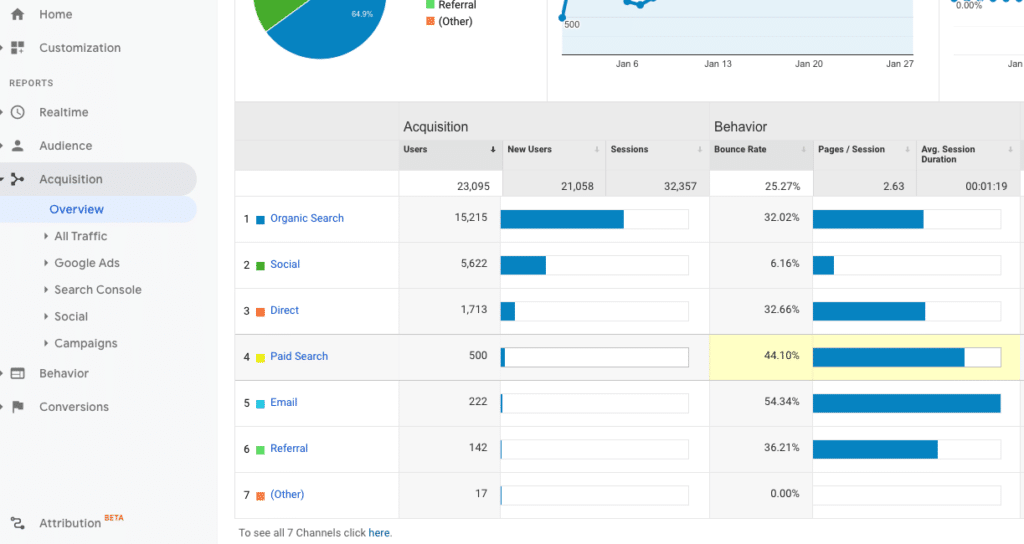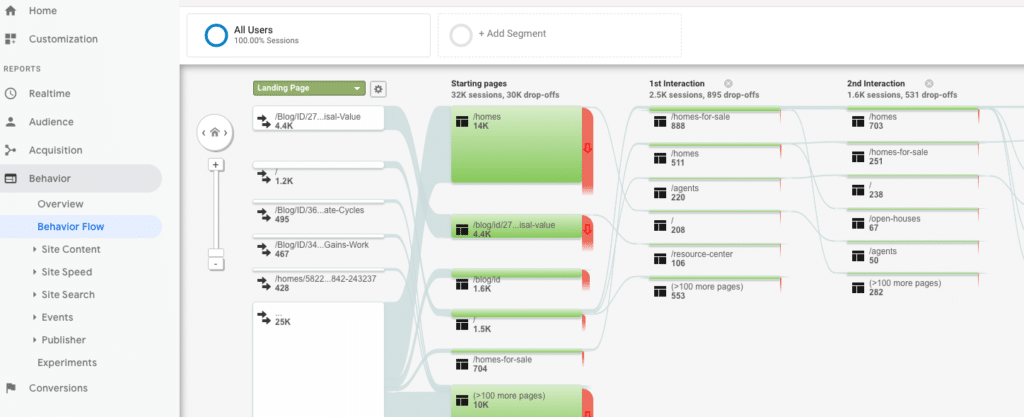
Your web visitors become leads and customers by following your website’s conversion path. This starts with a curious visitor on an entry page and ends with a customer completing a purchase, requesting a quote, or subscribing to a service. To improve your visitor to lead conversion rate, it’s important to understand the conversion path web visitors take. By tracking data and understanding customer behavior, we can optimize this entire process.
Aligning the Conversion Path and Buyer’s Journey
You can track a customer’s conversion path against the buyer’s journey or sales funnel. While the buyer’s journey illustrates a customer’s attitude as they confront a problem and learn about solutions, the conversion path shows roughly where they land at each step. The following are a few examples of how visitors convert to leads across the conversion path, and how this aligns with the buyer’s journey.
- Awareness: A customer might discover your website through a search ad, social media ad, organic social media encounter, organic search, or referring link.
- Consideration: As the customer considers options, they might return to your blog for more information, click a retargeting ad, subscribe to your newsletter or download a lead magnet.
- Decision: When they’re ready to purchase or contact you, a customer will most likely land on a product page, contact page, page for a specific store location, or another landing page.
Improving Visitor to Lead Conversion Rates with Data
Your conversion path and your website usability go hand-in-hand, and how your customers use your site might not be the same as how you expect them to use it. That’s why you need data.
If you already have a site and you’re reworking your web design or assessing your marketing strategy, use the data you have. You might observe a user on your site and gather experiential data, use Google Analytics to see how users navigate your site (more on this later), or both.
If you don’t have a website yet, you’ll want to make predictions, talk to members of your target market about how they would like to use your site, or watch users navigate a comparable website.
Turning Visitors into Leads with the Conversion Path: Step by Step
Each step in the conversion path and the buyer’s journey is important. The entire process is only as strong as the weakest link; if the buyer can’t find you, isn’t convinced enough to consider you, or isn’t convinced enough to buy from you, they won’t make a purchase. Look at the data to find your weak links, and try these strategies to improve visitor to lead conversion rates across the conversion path.
Step 1: Identify Entry Pages and Improve Awareness
To improve visitor to lead conversion rates, start at the beginning, at the awareness stage. This is a user’s first entry to your site, and the first step in the conversion path. Targeting your ideal audience from the start will help to improve visitor to lead conversion rates overall, and improving awareness overall will help boost your total lead numbers.
Use the Acquisition tab in Google Analytics to see how visitors arrive at your site and what they do when they get there. If you have Goals set, this will also show which users go on to complete an action, such as a purchase or an inquiry.

Google Analytic’s Acquisition section provides essential information about your website conversion path.
This does not show exactly which pages are most impactful to the first step in the conversion path. However, it does show which behaviors you can capitalize on to improve your visitor to lead conversion rates. Here are some strategies you might try depending on how your conversion path begins.
Organic search
This means pages of your site rank well for powerful search terms in your industry. Take a closer look at the Site Content information under the Behavior tab to see which pages, specifically, drive organic traffic. Find what these pages have in common—do they target similar keywords? Are they long or short? Are they mostly blogs or webpages? Do they primarily video, text, pictures, or a combination? Find similarities and try to create more pages like this.
Social
If users find you through your social channels, you’re tapped into the conversations around your brand and your industry. Dive into this further using the Site Content section under Behavior. Examine which pages users land on when they see you on social media, and which social channel they arrive from. Are your YouTube videos driving this traffic? Create more, and use these videos elsewhere on your website. Are your Twitter events and custom hashtags bringing in traffic? Put more time into this, and create downloadable content for it. Are your Instagram photos driving traffic? See which types of posts do best, try Instagram Stories and create a landing page just for your Instagram followers.
Direct
Direct traffic measures users going directly to your site, usually via a bookmark, a typed URL, and a few other ways. This can seem strange at this stage in the conversion process. How can a user go directly to your site if they’re hearing about you for the first time? Direct traffic might represent word of mouth, traditional marketing efforts like billboards, magazine features, or TV commercials, or event marketing, like trade shows. Add a question like “how did you hear about us?” to your forms, use a special QR code, or add a special coupon code to better track this type of traffic, so you know how to improve your visitor to lead conversion rates from this starting point.
Paid Search
Paid search means online advertising, such as search ads or social media ads. If you’re using Google Adwords for your advertising efforts, this tool will give you more information about how to optimize your advertising. You might try targeting different keywords, raising or lowering bids, or trying a new advertising platform.
Step 2: Analyze User Behavior and Encourage Consideration
At the consideration stage, potential customers know about your site and have most likely already visited. You can measure this with metrics like pages per session and dwell time, or take a closer look into the Behavior Flow section, under the Behavior tab. This will give you a clearer picture of what users do once they’re on your site, including pages they visit, what they click, and how long they’re reading. Understanding this data will show you improve your visitor to lead conversion rates by capturing your customer’s attention and respect. The content at this step on the conversion path positions your business above competitors, either through greater experience, authority, quality, service, or brand alignment.

In the Behavior tab, the Behavior Flow section in Google Analytics shows how customers move through your site.
You may need to compare data sets from different platforms, such as your email automation program and your Google analytics. For example, if your lead-nurturing emails show a high conversion rate compared to CTAs on your blog posts, focus on your emails. But remember to compare apples to apples; don’t compare a blog post targeted at awareness-stage visitors to a nurturing email targeted at consideration-stage visitors.
Blog posts and web pages
Your consideration-stage blog posts or web pages should be more informative and specific than awareness-stage content. Awareness stage content should cast a wide net using popular keywords and bringing in lots of traffic. Consideration stage content, on the other hand, is longer and more specific. It answers a question or an objection a user might have as they compare competitors. This content will probably get less organic traffic, but that’s okay. It’s designed to forge a connection with your visitors, so it should have longer dwell time and better conversion rates. To improve visitor to lead conversion rates with this content, use prominent CTAs, in-depth data, and highlight your competitive advantages, like high-quality, superior functionality, or a prestigious reputation.
Downloads
Downloadable content such as ebooks or templates are ideal for the consideration stage. Use your Behavior Flow chart and data on the relevant landing pages to see how well this content moves visitors from awareness to consideration. Try A/B testing different headings, CTAs, pictures, videos, color schemes, or other elements to optimize your landing page for conversions.
Emails
Look at your email metrics to see what you can improve on your nurturing emails. If you’re not getting many opens, take a closer look at your subject lines. If you’re getting opens, but not getting many clicks, try A/B testing different CTAs, formats or color schemes to get your readers’ attention. Test your emails to make sure they look great on desktop and mobile devices, and you don’t have any problems with spam flags or filters.
Step 3: Optimize Landing Pages and Close Sales
At the decision phase, your content makes the final push and wins your customer over. This is the last step in the conversion path, and the last opportunity to improve visitor to lead conversion rates. If you’re getting a lot of traffic, and your consideration-stage content has high dwell times and good click rates, but you’re not getting the sales or leads that you should be, you should take a closer look at your decision-stage content.
Decision stage content will vary depending on your sales cycle. Decision stage landing pages might be created around quotes, demos, particular locations, inquires, or simply products. Improving the conversion path at this stage means making these pages available at the right time, reducing barriers, and making them as appealing as possible.
Presenting solutions
to improve your visitor to lead conversion rate at this step in the conversion path, you have to improve your timing. Presenting your product or service as a solution right when the customer needs it can make the difference. This might mean using remarketing ads for customers who have visited your landing page, but weren’t ready at the time. Or, it might mean adding CTAs to consideration-oriented content to make a seamless transition. Consider how to move a customer forward across the conversion path, as well as how you might get them to return if they derail.
Reducing barriers
To increase your visitor to lead conversion rate, make the process as simple as possible. Get rid of extra form fields that don’t provide value. Provide multiple purchasing options. Make the page easy to navigate and check for bugs regularly.
Improving design
Purchasing your product or signing up for your service should make your customer feel good, and your landing page design should reflect it. Use A/B tests to test out larger images, videos, larger text, adding testimonials, or other elements, and see what works best. Test these elements one at a time so you can be sure you know which change made the difference.
If this seems like a lot to tackle, don’t panic. You don’t have to address everything all at once, and you can work with experts if you’re not sure how to improve your process. Optimizing and understanding your website conversion path at any level will help to improve your visitor to lead conversion rate.
